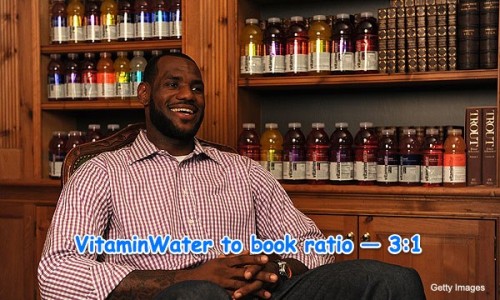What would you think is in a product called Vitaminwater? You’d probably guess water, and vitamins. Right? Not so fast:
“For too long, Coca-Cola has been exploiting Americans’ desire to eat and drink more healthfully by deceiving them into thinking that vitaminwater can actually prevent disease,” said CSPI litigation director Steve Gardner. “In fact, vitaminwater is no more than non-carbonated soda, providing unnecessary added sugar and contributing to weight gain, obesity, diabetes, and other diseases.”
First off, let me say that CSPI [Center for Science in the Public Interest] is not one of my favorite references. They are a special-interest group that routinely pushes a vegan and vegetarian agenda, distorting or ignoring evidence in favor of the health benefits of eating animal products. (Oh boy, going to get some hate mail for saying that.)
But in this case they’re right. Like they say, even a blind squirrel occasionally finds a nut. And the nut here is that vitaminwater isn’t any better for you than a can of Coke:
It’s important to keep in mind that Glacéau has listed one bottle of Vitaminwater as 2.5 servings. That means you would have to drink less than half a bottle to get what the numbers on the back say. If you drink the whole bottle, though — which will probably be the case, since the bottles are fairly small — you have to multiply each number by 2.5. Right away the packaging appears to be misleading.
Here are the nutrition facts and ingredients from a bottle of “charge” Vitaminwater:
Nutrition Facts:
- Calories: 50
- Total fat: 0g
- Sodium: 0mg
- Potassium: 60mg
- Total carbohydrates: 13g
- Sugar: 13g
- Protein: 0g
- Vitamin C: 40%, Vitamin B3: 20%, Vitamin B6: 20%, Vitamin B12: 20%, Vitamin B5: 20%
- Potassium: 150mg per bottle
Ingredients: vapor distilled/deionized water, crystalline fructose, citric acid, vegetable juice (color), natural flavor, ascorbic acid (vitamin C), vitamin E acetate, magnesium lactate (elecrolyte), calcium lactate (electrolyte), zinc picolinate, monopotassium phosphate (electrolyte), niacin (B3), pantothenic acid (B5), pyridoxine hydrochloride (B6), cyanocobalamine (B12)
The big red flag here is the amount of sugar. There are 13 grams of sugar in one serving, so an entire bottle contains about 32.5 grams of sugar. For the sake of comparison, a can of Coca-Cola Classic contains about 39 grams of sugar.
But they added vitamins, didn’t they? Well … sort of:
Now, let’s take a good look at the “vitamins” that are in this “nutrient enhanced beverage” of kiwi-strawberry vitamin water. According to the label, each serving contains 10% of your daily requirements for Vitamins A, B3, B6, B12, and B5 and a hefty 40% of your daily allowance of Vitamin C. The problem is that these “vitamins” are not attached to any whole food like strawberries or kiwis.
Remember, those whole foods were missing from the ingredients. Therefore, the live enzymes needed to help your body absorb the vitamins into your cells are not there. It is a nutrition fact that whole foods like fruits and vegetables contain live enzymes, which act as catalysts for vitamins and minerals to work in your cells. Without those whole food properties, isolated vitamins are not easily absorbed by the body and are more than likely eliminated in the toilet. So, how many of those vitamins in the vitamin water are actually being put into use by the body? Probably about as many as you could get from eating cotton candy.
Now here’s the kicker. This story was just in the news because a judge ruled that the lawsuit can go forward. The reasoning was that:
Reasonable consumers should [not] be expected to look beyond misleading representations on the front of the box to discover the truth from the ingredient list in small print on the side of the box.
I think that’s a great point. But it’s government policy, driven by lawsuits, that makes manufacturers put those nutrition labels on to begin with. If you want to say that they can’t make misleading claims on the front of the bottle, that’s great. But if even the courts are saying nobody reads the labels on the back … what are they there for?












